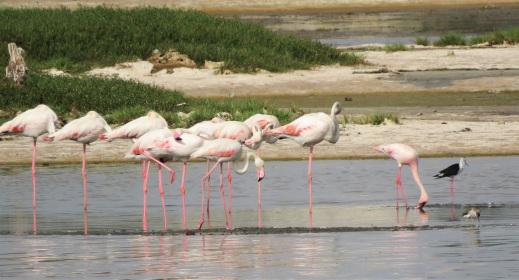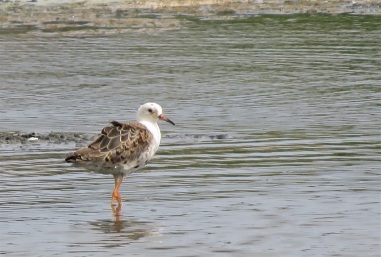A New Shade of Pink (Technopole #222)

Yesterday’s weekly Technopole visit once again turned up a new species for the site. I’d been scanning and counting the numerous waders on the SW end of the main lake for over an hour, when I turned my attention the flock of Greater Flamingos that were feeding nearby. Two ringed birds proved to be tricky to read, one ring being very faded and the other one, also on an adult bird, was largely covered in mud – more on this further down in this post. I then started to count the flock, and after reaching the 200 mark (there were a total of 289 birds, so nearly 120 more than last week), I noticed a much hoped-for different shade of pink, darker and more intense: an adult Lesser Flamingo!
The noticeably smaller size, bright orange eye, and largely uniform dark crimson bill (or is it vermilion?) bill quickly confirmed the ID.
As far as I know, this is the first record of the species at Technopole, though of course that doesn’t mean that it hasn’t already occurred here: it may well have gone unnoticed or else unreported (which given the lack of any sort of bird observation recording system or central database would not be surprising! More on that in another post…)
It’s definitely not an unexpected addition (as predicted a few months ago), given that the species must regularly migrate along Senegal’s coast between the Senegal and Saloum deltas. However, neither Morel & Morel nor Sauvage & Rodwell mention the species from the Dakar atlas square. This bird obviously got mixed in with a group of Greater Flamingos, possibly on their way down to the Saloum or moving between post-breeding dispersal areas in the region (Lac Rose, and soon maybe Lac Tanma when it will start filling up).
Lesser Flamingo is listed as a Near-Threatened species on the IUCN Red List of Threatened Species. In short, the “NT” category typically includes declining or otherwise vulnerable species that in the medium to longer term are faced with the risk of extinction; as such they are likely to qualify for a threatened category in the near future. Despite having a vast range in the Old World, covering large parts of sub-Saharan Africa and the Indian subcontinent, Phoenicopterus (or Phoeniconaias) minor breeds only in a handful of sites in the world, with just six main colonies located in Mauritania, South Africa, Namibia, Botswana, the Tanzanian Rift Valley, and NW India. Other sites may be used irregularly, e.g. in Kenya and Pakistan.
Its global population is still pretty substantial with some 2-3 million individuals, mostly in East Africa, but it is extremely vulnerable to changes in conditions of those very few sites, whether induced by climate change or by a range of human disruptions to the environment. For instance, the IUCN species’ fact sheet tells us that “the proposed large-scale soda ash extraction at Lake Natron, the most important breeding colony, although currently on hold, would be disastrous for this species and, were this to happen, the species may qualify for uplisting to a higher threat category.” Read up a little bit more about this conservation issue and the actions that BirdLife and partners have taken here. Excessive predation by Jackals, African Wolves and even Warthogs and Honey Badgers may result in poor or even complete failure of breeding success. And at least in Mauritania poaching is also a problem.
The West-African population is thought to number about 15,000-25,000 birds (compared to over a million for East Africa), concentrated in the lower Senegal valley with the most regular breeding site being the lagoons of Aftout es Sâheli in the Diawling NP in southern Mauritania. Up to 46,500 birds have been counted in the Senegal delta (Feb. 1990), but breeding is not annual: according to Isenmann et al. it occurred only in 1965, 1988 (though all attempts failed that year), 2000, 2005, and 2010; it was suspected but not confirmed in 1998, 1999 and 2007. More recently, the species has bred at least in 2014 (a bit more info is available on the Diawling NP’s website, and see this video from the parc).
Its movements, and generally speaking its overall ecology, are largely dictated by feeding conditions as it is a highly specialised species; as a result, birds tend to respond rapidly to changing water levels and food availability (spirulina and other blue-green algae, small invertebrates). Fun fact: the Lesser Flamingo’s bill contains up to 10,000 microscopic lamellae!
At least one of the ringed Greater Flamingos was Spanish: I don’t have full details as I’m yet to submit the sighting, but judging by the code (white ring with black inscription “2|CZR”) it’s a bird that was ringed in 2013 at the Laguna de Fuente de Piedra in Malaga, which is also the origin of one born in 2014 and seen in June 2015 at Technopole. Coincidentally, the three ringed birds from the Camargue that I found last year were seen on the same date as yesterday’s birds: 6 August.
Other than that, there was an interesting gull that will require a bit more work, and probably better pictures, in order to establish its ID. I’m suspecting Kelp Gull because of the massive bill and the large, stocky appearance, but am by no means a gull expert and will want to consult a few others first (contributions welcome!). I’ll get back to this one in due time – if it is indeed a Kelp rather than Lesser Black-backed Gull, one of which was present nearby, then it would mean yet another potential addition to the site list.
As I mentioned, I’d been counting waders for the first hour or so, which I continued doing on the opposite end of the pool close to the golf club house, where more birds were feeding. This resulted in some pretty good numbers especially for Ruff with a minimum of 598 (!) birds, at least one of which was colour-ringed with a yellow flag in combination with other rings – unfortunately it flew off shortly after I’d found it, never to be seen again… probably a Dutch bird. Some of the males were still largely in breeding plumage, such as this one:
Another wader highlight was the very decent diversity of calidris sandpipers: two summer-plumaged adult Dunlins, no less than seven Knots (my highest count here), with a supporting cast of several Curlew Sandpipers (9), Sanderlings (11) and Little Stints (12). There were now only 22 Black-tailed Godwits and just one Marsh Sandpiper, while the four Avocets seem to have finally moved on. Two Common Sandpipers on the other hand were most likely newly arrived birds.
[Note (13/8/17): it turns out that the Lesser Flamingo had already been photographed on August 3rd by J-M Dupart, but apparently was not identified at such at the time; I triple-checked my pictures of the flock that was present on 29/7 but it definitely wasn’t present at the time.]









































































































































































































Trackbacks / Pingbacks